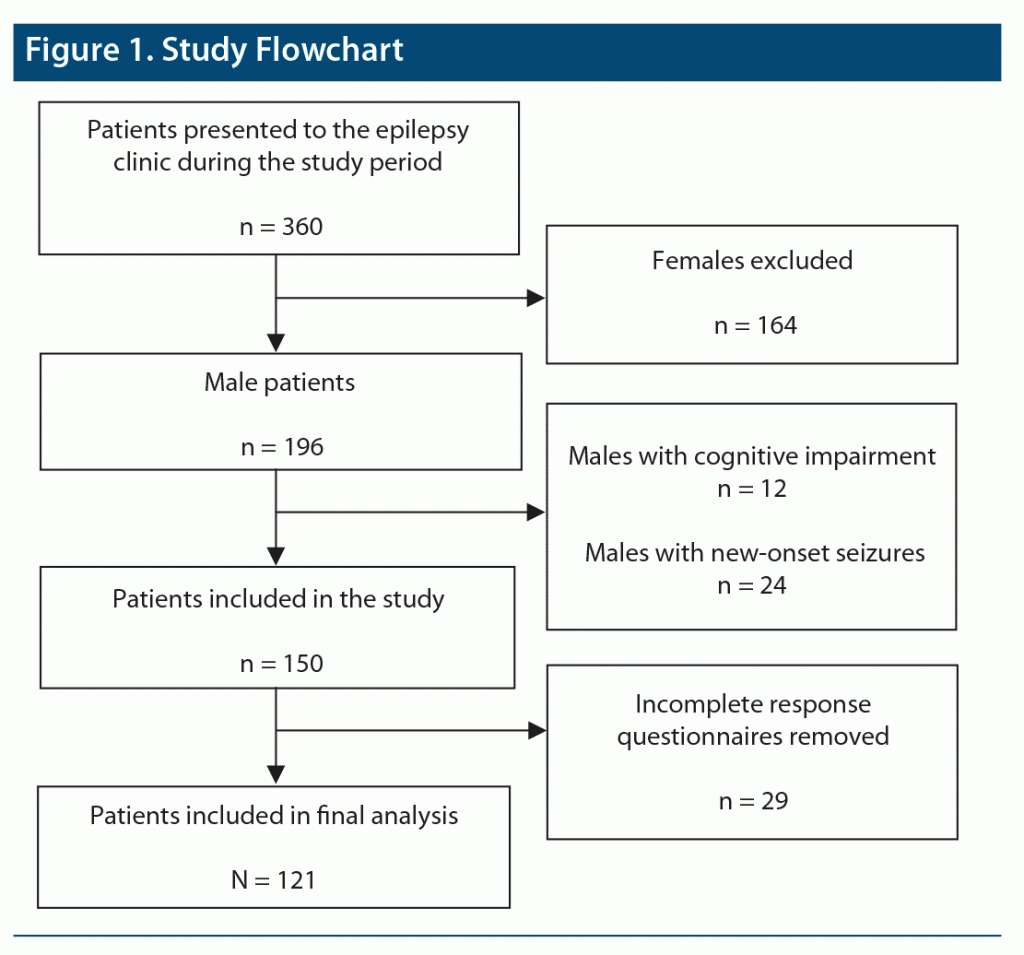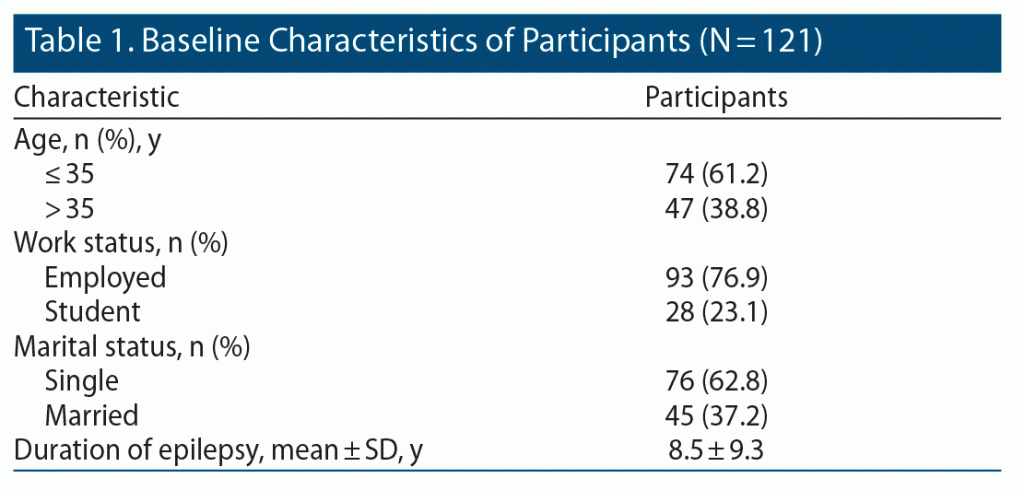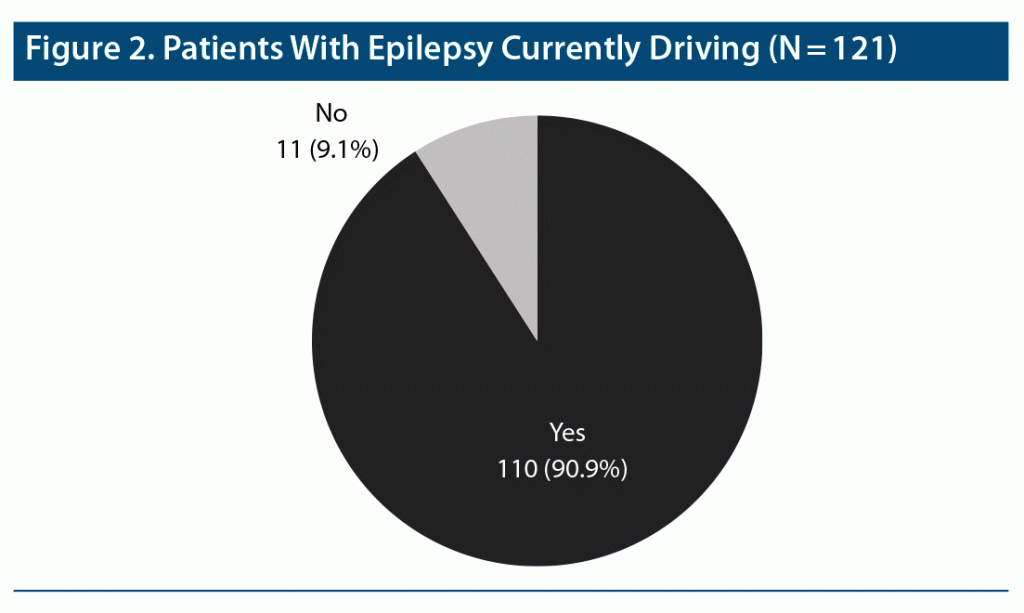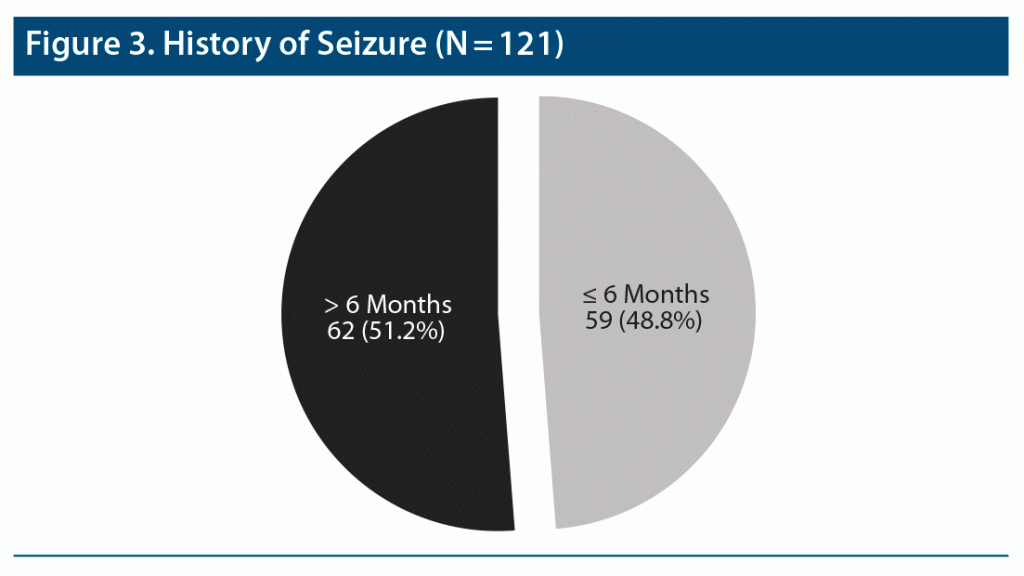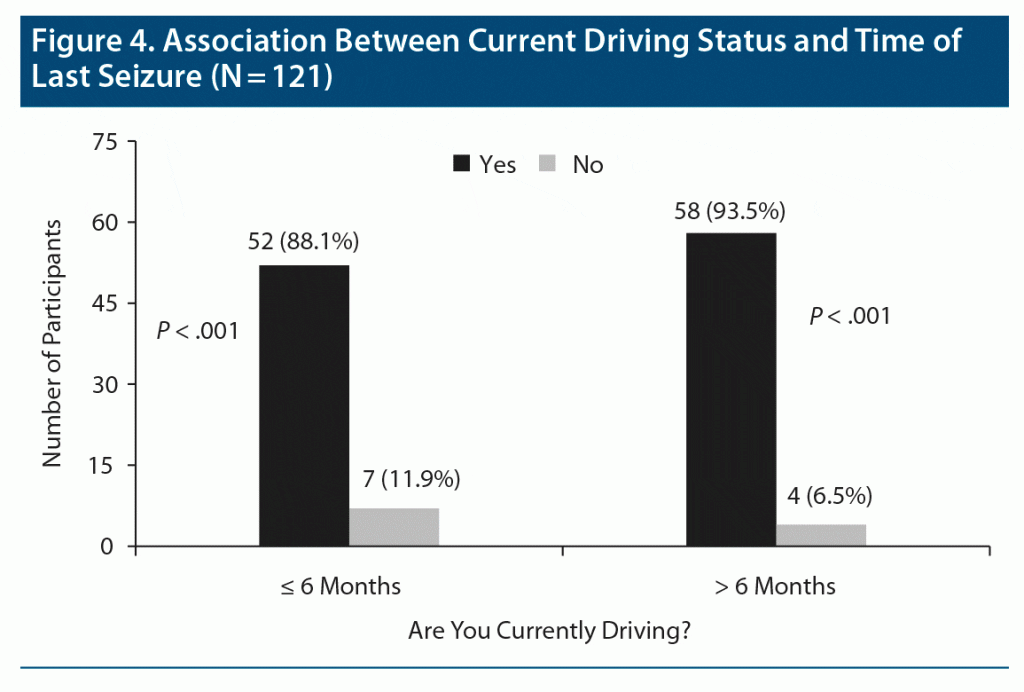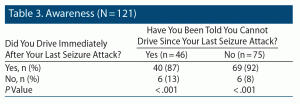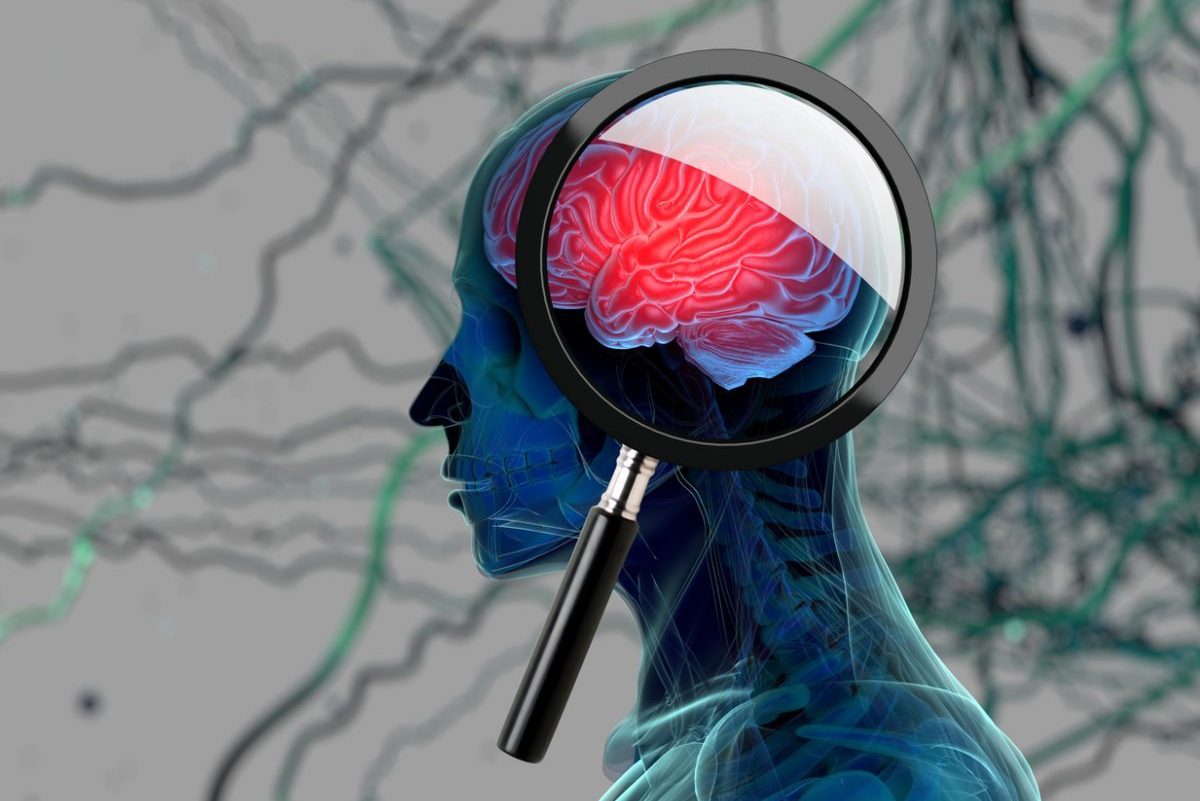ABSTRACT
Objective: Patients with epilepsy are instructed to avoid high-risk situations such as certain occupations and driving to prevent harm to themselves and others. There is considerable variation in standards to decide if a patient with epilepsy is fit to drive among various countries worldwide, and these patients often continue to drive despite being advised not to. The objective of this study was to determine if patients with epilepsy and uncontrolled epilepsy are driving, the awareness of epilepsy patients regarding driving, and whether physicians are advising the patients to stop driving.
Methods: A clinic-based study was conducted in Saudi Arabia from June 2018 through January 2019 with structured interviews of consecutively recruited male patients with established epilepsy diagnosis. Demographic factors, employment status, control of seizures, and awareness of driving restrictions were documented.
Results: The response rate was 80.6%. Of the 121 participants (mean age of 35.97 years), 110 (90.9%) were driving, and 39% of those patients were married. Also, 76.9% of participants were employed. Of the participants, 48.8% had 1 seizure in the last 6 months, and 88% of those patients were driving; 51.2% had not had a seizure in the last 6 months, and 93% of those patients were driving. Additionally, 17.4% reported a seizure attack while driving. Only 38% of respondents were aware they should stop driving, whereas 62% were unaware of driving restrictions.
Conclusions: There is a definite need to establish a driving policy for patients with epilepsy and to optimize the standards of care of epilepsy patients in Saudi Arabia to ensure minimization of harm to both patients and the public.
Prim Care Companion CNS Disord 2022;24(2):21m02967
To cite: Aljaafari D, Ishaque N, Alsulaiman FA, et al. Driving habits among patients with epilepsy in a tertiary care hospital in Saudi Arabia. Prim Care Companion CNS Disord. 2022;24(2):21m02967.
To share: https://doi.org/10.4088/PCC.21m02967
© Copyright 2022 Physicians Postgraduate Press, Inc.
aDepartment of Neurology, College of Medicine, King Fahad Hospital of the University, Imam Abdulrahman Bin Faisal University, Dammam, Saudi Arabia
*Corresponding author: Danah Aljaafari, MD, Department of Neurology, College of Medicine, Imam Abdulrahaman Bin Faisal University, 2835, King Faisal Rd, Dammam 34212, Kingdom of Saudi Arabia ([email protected]).
Epilepsy is a chronic neurologic disorder characterized by recurring seizures. Prevalence of active epilepsy is reported to be 6.54 per 1,000 inhabitants in Saudi Arabia.1 Patients with epilepsy are instructed to avoid high-risk situations such as certain occupations and driving to prevent them from harming themselves and others. Hence, restriction on driving can help reduce incidence of road traffic accidents.1 Epilepsy is most prevalent in people aged 35 to 65 years, and restriction on driving in this age group can have a significant impact on their daily lives including employment and social life.2
The fatalities associated with epilepsy and driving represent around 4.2% of all medically related accidents.3 There is considerable variation in standards to decide if a person with epilepsy is fit to drive among various countries worldwide.4,5 There is lack of local or national laws in Saudi Arabia, to the best of our knowledge, to guide physicians regarding driving restrictions for patients with epilepsy, which means there are some epilepsy patients who are driving and possibly unaware of restrictions.
The objective of this study was to determine if patients with epilepsy and those with uncontrolled epilepsy are driving, to assess the awareness of these patients regarding driving, and to determine whether physicians are advising patients to stop driving.
METHODS
This descriptive cross-sectional study was conducted at King Fahd Hospital of University (KFHU) in Al Khobar, Eastern province of Saudi Arabia. KFHU is a tertiary care hospital affiliated with Imam Abdulrahman Bin Faisal University and is one of the largest hospitals in the eastern province of Saudi Arabia. The epilepsy clinic of KFHU provides services to a large number of patients with epilepsy 3 times per week. A consecutive sampling technique was used to select participants visiting the epilepsy clinic between June 2018 and January 2019. Male patients aged ≥ 18 years with diagnosis of epilepsy for at least 1 year were included in the study. Male patients aged < 18 years, female patients (as they were not allowed to drive at time of study), and patients with cognitive impairment or any other medical condition that might cause restriction to drive were excluded. Patients with new-onset seizures were also excluded due to incomplete workup and no established diagnosis of epilepsy. The exclusion criteria were applied at initial sampling. A study flowchart is included in Figure 1.
A self-administered questionnaire was created for use in this study. In the first stage, the questionnaire was developed by conducting a thorough literature review of publications addressing epilepsy and driving. A simple questionnaire in Arabic was subsequently created. This questionnaire was reviewed by 3 different neurologists at our center, and changes were made according to their suggestions. The questionnaire was administered to 20 patients in the pilot phase, and changes were made according to any issues found. The final questionnaire with all changes incorporated was used in this study. Uncontrolled epilepsy was defined as the patient having a seizure in the last 6 months. The estimated sample size needed to achieve a precision of ± 0.05% at a 95% CI was 111 participants. Patients who did not complete the questionnaire were excluded. The study included 150 patients, but 29 were excluded due to incomplete responses. A total of 121 patients were included in the final analysis.
All categorical variables obtained from the questionnaire were presented in the form of frequencies and percentages, including age group, marital status, working status, current driving status, seizure-free interval (≤ 6 months or > 6 months), history of seizure while driving, history of road traffic accidents while driving, and awareness. Means and SDs were calculated for age and duration of epilepsy. Data were analyzed using IBM SPSS. 21.
All questionnaires were anonymous, and confidentiality was ensured. A cover page was provided to explain how to complete the questionnaire. Written consent was obtained from all participants. This study was approved by the institutional review board of Imam Abdulrahman Bin Faisal University.
RESULTS
A total of 150 questionnaires were distributed, and 121 participants completed the survey (80.6% response rate). The mean ± SD age of the participants was 35.97 ± 14.7 years. A majority of the participants (61.2%) were ≤ 35 years, and 76 patients (62.8%) were single, while 45 (37.2%) were married. Also, 93 (76.9%) participants were employed, and 28 (23.1%) were students. The mean ± SD duration of having epilepsy was 8.5 ± 9.3 years. Table 1 provides the patients’ baseline characteristics and disease characteristics.
Of 121 patients with epilepsy, 110 (90.9%) were currently driving (Figure 2). Of the 110 patients who were driving, 43 (39.1%) were married and 67 (60.9%) were single.
Participants were categorized into 2 groups based on a seizure-free interval of 6 months. All participants who had their last seizure ≤ 6 months were considered to have uncontrolled epilepsy (59 of 121, 48.8%), while those who had their last seizure > 6 months ago were considered to have controlled epilepsy (62 of 121, 51.2%) (Figure 3). Also, 52 of the 59 participants with uncontrolled epilepsy were currently driving, and 58 of 62 participants who were seizure free for the last 6 months were driving (Figure 4).
Of 121 participants with epilepsy, 21 (17.4%) had a history of seizure attack while driving (Table 2). Of the 21 patients who experienced seizure during driving, 18 (85.7%) had an accident because of seizures with no major injuries, disabilities, or reported death, and only 1 of 18 reported having minor bruises due to road traffic accidents. Only 5 participants (4%) had their first seizure attack while driving.
Only 46 (38%) patients with epilepsy were aware that they should not drive for a certain period after the seizure, while the majority (75 patients, 62%) were never told not to drive after the diagnosis of epilepsy (Table 3). In patients who were aware of driving restrictions, the duration they were advised to stop driving varied from 1 to 12 months. Of 46 patients who knew not to drive after the diagnosis of epilepsy, 40 (87%) had started driving immediately after a seizure.
DISCUSSION
Restrictions on patients with epilepsy regarding driving have been in place for more than 100 years but vary widely between countries. The ability to drive has vast implications for patients with epilepsy and impacts employment, social life, and hospital visits. The major concern for patients with epilepsy is being restricted from driving, which affects their quality of life.6 In 1 study,7 the majority of patients stated that driving restrictions reduced their quality of life, and 70% believed that these restrictions carry a social stigma.
In this cross-sectional survey-based study, we found that almost all patients with epilepsy were driving, and nearly one-fifth had history of seizure while driving. Almost two-thirds of all participants were unaware that they should not drive, and 9 of 10 participants who were aware that they should stop driving resumed driving immediately after a seizure.
The mean ± SD age of participants in this study was 35.9 ± 14.7 years, which is similar to other studies from Saudi Arabia.8,9 Close to two-thirds of participants in this study were aged < 35 years, which is a productive time of life, and patients usually travel as part of their job or to socialize and might choose to drive despite knowing the associated risks.
About three-fourths of the participants were working, which is higher than other studies that reported nearly half of their participants were employed, had uncontrolled seizures, and continued to drive.10,11 However, the number of participants in our study was also higher than other Saudi studies.9,12 Our finding of a high employment rate might be related to the specific population to which our hospital caters, which is more educated and more likely to be employed. Also, these employed patients, despite having uncontrolled epilepsy, may have to drive to help their families financially. Xu et al13 studied the predictors of returning to driving within the first year after diagnosis of epilepsy. Most of the participants who returned to driving did so because of socioeconomic factors. They13 found that driving to school or work before diagnosis was a strong predictor for driving after diagnosis. Other factors associated with return to driving were lack of comorbidities, absence of seizure occurrence in the preceding 8 months, and using 1 or no antiepileptic drug. The authors13 also reported that more than half the patients who have recurrent seizures were driving at follow-up.
Nine of 10 participants in this study were driving, which is in line with results from a few other studies from Saudi Arabia,8,9,12,14 but is significantly higher than that reported from other countries.15 In a German study, Willems et al16 reported that 15.1% (n = 31/205) of patients with uncontrolled epilepsy were driving on a regular basis. Reasons to continue to drive in another study8 were cited as control of seizures and lack of fear for accidents. Our finding of a high number of patients driving might be due to women not being allowed to drive at the time of the study. Therefore, men were responsible for transporting women as well as meeting the needs of their households. Lack of alternative transportation methods like metros or city buses might be a reason to return to driving in our population and may contribute to noncompliance with driving regulations.
The most striking result of this study was that two-thirds of respondents were unaware that they should avoid driving, although physicians provide advice about driving restriction as a routine in the epilepsy clinic at time of epilepsy diagnosis and at follow-up visits. We believe this might be because some physicians do not seriously discuss this issue regularly with patients due to lack of local laws or guidelines in this regard. Similar results were reported in another study,12 which found that only one-fourth of their participants were aware that they should avoid driving.14
Half of participants in this study had uncontrolled seizure in the last 6 months. Similar results were reported by Aljohani et al,17 who found that patients with uncontrolled seizures in the western region of Saudi Arabia had higher risk of road traffic accidents compared to those with well-controlled seizures. They17 also found that 85.9% of patients with epilepsy are driving and 20.6% had a history of experiencing seizure attack while driving. Another study14 also reported that one-fifth of patients with epilepsy had a seizure attack while driving.
While seizure-free interval (SFI) is used by many countries as a predictor of return to driving, the optimal SFI duration for safe driving is variable, and in the United States each state has its own policy. Most states prescribe SFI ranging from 3 to 12 months, while some states allow individualization of cases based on seizure characteristics and doctor recommendations.13
A 2003 study18 from Arizona evaluated the rate of car accidents before and after changing the epilepsy-free interval from 12 months to 3 months. The results showed that the rate of seizure-related crashes did not significantly increase in the state of Arizona after the SFI was reduced from 12 to 3 months.18
The results of this study are significant from a public safety perspective, as we determined how many patients with uncontrolled epilepsy are driving and how many of them are unaware of driving restrictions. The rate of road traffic accidents in Saudi Arabia is reported to be higher than other countries. Published data from Saudi Arabia show that there are 526,000 traffic accident a year costing 5.6 billion dollars, with a costlier 17 fatalities daily.19 Saudi Arabia ranked 23 in terms of traffic accident fatalities with 27/100,000 deaths.19 This study can help to initiate steps to put laws and guidelines in place regarding driving restriction for patients with epilepsy. Physicians should also adapt a more aggressive approach, advising patients to stop driving until their seizures are controlled. They should arrange a meeting with the patient to discuss driving restrictions and give the patient adequate time to ask questions. Physicians should also document their advice. One suggested solution to restrict driving among patients with epilepsy is to pass a regulatory law that their automobile insurance might not cover any crash that occurs while driving illegally. If a patient with uncontrolled seizures continues to drive, it may be necessary to report to the driving authorities. The most important limitation is that it was conducted in a single tertiary care hospital; therefore, data need to be interpreted with caution.
CONCLUSION
Taken together, the results of this study indicate that there is a lack of patient education about driving as a lifestyle modification after epilepsy diagnosis and a lack of patient adherence to physicians’ recommendations, probably due to the absence of a clear driving policy. The current findings substantially add to the growing body of literature on the understanding of the risks of driving with epilepsy in Saudi Arabia. There is therefore a definite need to establish a Saudi driving policy for patients with epilepsy to optimize the standards of care in our country and to ensure minimization of harm to patients and the public.
Submitted: March 9, 2021; accepted June 18, 2021.
Published online: March 17, 2022.
Potential conflicts of interest: None.
Funding/support: None.
Clinical Points
- Counseling regarding lifestyle modification is an important part of epilepsy treatment to ensure patient and community safety; one of the most important topics to discuss is driving limitations.
- The lack of a clear driving policy for people with epilepsy leads to discrepancy in physician recommendations and patient awareness.
- Provision of alternative transportation methods, restrictions in automobile insurance coverage for accidents caused by illegal driving, and a more aggressive approach to driving safety counseling by physicians are some solutions to increase awareness and ensure compliance.
References (19)

- Al Rajeh S, Awada A, Bademosi O, et al. The prevalence of epilepsy and other seizure disorders in an Arab population: a community-based study. Seizure. 2001;10(6):410–414. PubMed CrossRef
- Devlin AL, Odell M, Charlton JL, et al. Epilepsy and driving: current status of research. Epilepsy Res. 2012;102(3):135–152. PubMed CrossRef
- Krumholz A. Driving issues in epilepsy: past, present, and future. Epilepsy Curr. 2009;9(2):31–35. PubMed CrossRef
- Krauss GL, Ampaw L, Krumholz A. Individual state driving restrictions for people with epilepsy in the US. Neurology. 2001;57(10):1780–1785. PubMed CrossRef
- Ooi WW, Gutrecht JA. International regulations for automobile driving and epilepsy. J Travel Med. 2000;7(1):1–4. PubMed CrossRef
- Gilliam F, Kuzniecky R, Faught E, et al. Patient-validated content of epilepsy-specific quality-of-life measurement. Epilepsia. 1997;38(2):233–236. PubMed CrossRef
- Arcot Jayagopal L, Samson KK, Taraschenko O. Driving with drug-resistant and controlled seizures from a patient’s perspective: Assessment of attitudes and practices. Epilepsy Behav. 2018;81:101–106. PubMed CrossRef
- Abduljabbar MS. Epilepsy and driving in Saudi Arabia: a pilot study. Neurosciences (Riyadh). 2000;5(1):26–29. PubMed
- Algahtani H, Shirah B, Algahtani R, et al. Epilepsy and driving: local experience from Saudi Arabia. Epilepsy Behav. 2019;99:106401. PubMed CrossRef
- Bautista RE, Wludyka P. Driving prevalence and factors associated with driving among patients with epilepsy. Epilepsy Behav. 2006;9(4):625–631. PubMed CrossRef
- Stanaway L, Johnson RH, Lambie DG. Epilepsy and driving. N Z Med J. 1983;96(735):525–528. PubMed
- Al Zaid EH. Prevalence of patients with epilepsy unfit to drive. J Family Community Med. 2019;26(1):51–56. PubMed CrossRef
- Xu Y, Hackett ML, Glozier N, et al. Return to driving after a diagnosis of epilepsy: prospective registry study. Epilepsia. 2018;59(3):661–667. PubMed CrossRef
- Al Taho AJ. Driving eligibility among epilepsy patients in Saudi Arabia. Egypt J Hosp Med. 2018;73(5):6691–6695. CrossRef
- Elliott JO, Long L. Perceived risk, resources, and perceptions concerning driving and epilepsy: a patient perspective. Epilepsy Behav. 2008;13(2):381–386. PubMed CrossRef
- Willems LM, Reif PS, Knake S, et al. Noncompliance of patients with driving restrictions due to uncontrolled epilepsy. Epilepsy Behav. 2019;91:86–89. PubMed CrossRef
- Aljohani WI, Alsohime BF, Nawwab MA, et al. Epilepsy patients in saudi arabia, are they eligible to drive? Int J Health Sci. 2017;4(2):1875–1879.
- Drazkowski JF, Fisher RS, Sirven JI, et al. Seizure-related motor vehicle crashes in Arizona before and after reducing the driving restriction from 12 to 3 months. Mayo Clin Proc. 2003;78(7):819–825. PubMed CrossRef
- Central Intelligence Agency. The World Factbook. 2018. Accessed January 31, 2022. https://www.cia.gov/the-world-factbook/about/cover-gallery/2018-cover/
Please sign in or purchase this PDF for $40.
